Welcome to the ultimate leg press foot placement showdown! In one corner, we have the almighty calves. On the other, the hulking quads and the elusive hamstrings and glutes are somewhere in the back.
It’s a battle of the muscles, and the leg press machine is our arena. But before we get started, I will mostly be talking about foot placement because, let’s face it, without the right footing, we’re just flailing around like a bunch of landlubbers.
So, strap on your peg legs, adjust your eye patches, and let’s get ready to rock the plank of gains!
What is a Leg Press?
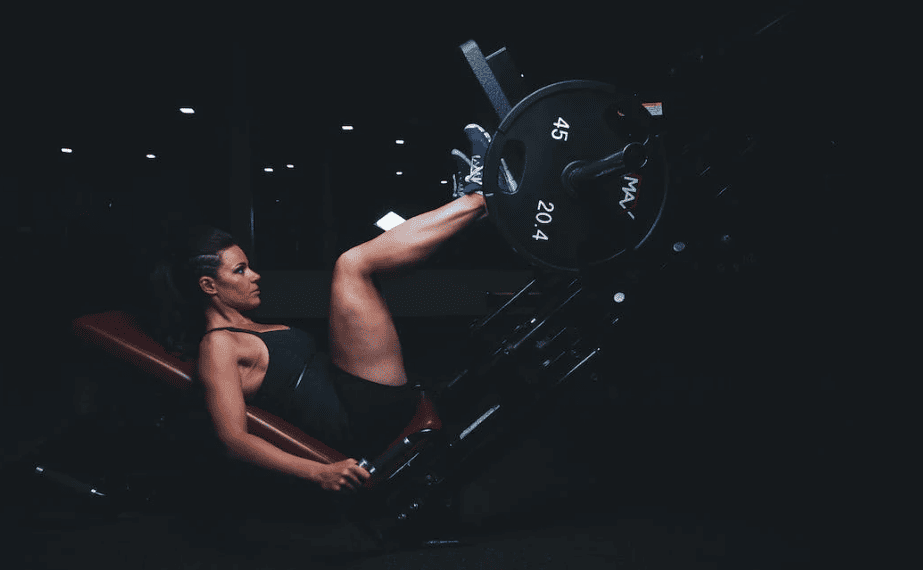
A Leg Press is a piece of gym equipment used for strengthening and toning the muscles in the legs, particularly the quadriceps, hamstrings, and glutes. It typically consists of a large platform on which the user lies, with a movable sled attached to a set of weights.
The user pushes against the sled with their feet, extending their legs to move the weight, and then releases the sled to lower it.
The Leg Press is commonly used as a lower-body workout option for individuals with limitations in performing exercises such as squats or lunges due to physical restrictions or injuries.
Leg Press Foot placement
In Leg Press exercises, foot placement is a crucial aspect that must be considered to target specific leg muscles.
Leg Press foot placement basics involve positioning the feet on the sled at shoulder-width apart, with the toes pointed slightly outward. This stance primarily works on the quadriceps muscles.

To work on the hamstrings, the feet should be placed higher on the sled, with the toes pointing straight up. Placing the feet lower on the sled with toes pointing downward primarily targets the glutes.
Here is a table of common Leg Press foot placements and their corresponding muscle objectives:
| Foot Placement | Muscle Targeted |
|---|---|
| Shoulder-width apart with toes pointed slightly outward | Quadriceps |
| Higher on the sled with toes pointed straight up | Hamstrings |
| Lower on the sled with toes pointed downward | Glutes |
| Narrow stance | Inner thigh (adductors) |
| Wide stance | Outer thigh (abductors) |
There are certain combinations of leg press that people utilize for optimum effectiveness- here are the foot placements:
| Foot Placement | Description | Muscles Targeted |
|---|---|---|
| Shoulder-width apart | Feet are positioned shoulder-width apart on the footplate. | Quadriceps, glutes, hamstrings |
| High and narrow | The feet are positioned close together with toes pointing upwards toward the top of the platform. | Calves, quadriceps, glutes |
| Low and wide | Feet are positioned wider than shoulder-width apart with toes pointing outwards. | Inner thighs, glutes, quadriceps |
| High and wide | Feet are positioned wider than shoulder-width apart with toes pointing outwards towards the top of the platform. | Outer thighs, glutes, quadriceps |
| Single-leg | One foot is positioned on the footplate while the other leg is lifted off the platform. | Quadriceps, glutes, hamstrings, core |
Here are the best foot placements for Leg Press:
Best Leg Press Foot Placement For Calves
When considering the best foot placement for the leg press exercise, one area that often gets overlooked is the calves. A lower position is the best foot placement for activating the calves during the leg press.
This means placing your feet close together at the edge of the platform, with your toes pointing upwards towards the top and heels off the platform. This foot placement will shift the exercise’s emphasis towards the calves, as they are required to work harder to push the weight upwards.
To carry out a leg press for the calves, these ought to be your following foot placements:
| Step | Description |
|---|---|
| 1 | Sit on the leg press machine with your back flat against the backrest and your feet shoulder-width apart on the footplate. |
| 2 | Slowly move your feet lower towards the bottom of the platform, keeping your toes pointed upwards. |
| 3 | Bring your feet closer together, so they are positioned directly under your hips. |
| 4 | Ensure your heels remain off the platform throughout the exercise. |
| 5 | Lower the weight down, keeping your legs at a 90-degree angle. |
| 6 | Push the weight back up, focusing on pushing through your toes to activate your calves. |
| 7 | Repeat for the desired number of reps. |
By incorporating the leg press with low foot placement, you can effectively target your calf muscles and reap the following benefits:
Increased Strength
The leg press with a low foot placement is an excellent way to build strength in your calf muscles. By targeting this area, you can improve your overall lower body strength and power, translating to improved athletic performance and better daily function.
Defined Calf Muscles
For those looking to achieve defined calf muscles, the leg press with the above foot placement can be a valuable tool. Regularly targeting this area can help tone and shape your calf muscles, resulting in a more aesthetically pleasing appearance.
You may also like to read:
- 6 Best Bench Back Exercises To Strengthen Your Back Like A Pro
- 21+ Best Exercises For Beginners
- What Exercise Machine Burns The Most Belly Fat?
Best Leg Press Foot Placement For Quads
Regarding leg day, the leg press is an effective exercise for targeting the quadriceps, the muscles on the front of the thigh. The best leg press foot placements for the quads to help you maximize your workout are:
1. Shoulder-width apart
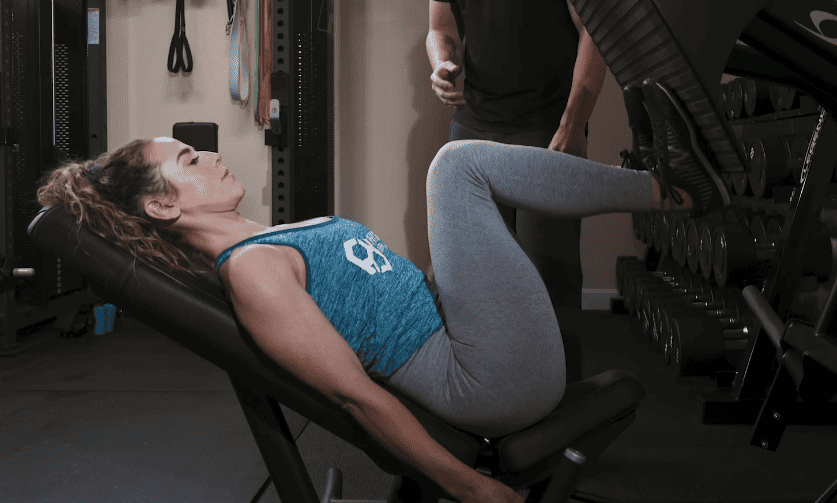
Feet positioned shoulder-width apart on the footplate is a standard foot placement for the leg press. This placement targets the quadriceps while also engaging the glutes and hamstrings. This placement is ideal for beginners or those seeking a basic quadriceps workout.
2. High and narrow
A high and narrow foot placement is recommended for a more targeted quadriceps workout. Place your feet together, with your toes pointing upward towards the platform’s top.
This placement increases the range of motion and puts more emphasis on the quadriceps, resulting in a more intense workout. The high and narrow foot placement is particularly effective for individuals with shorter legs.
3. High and wide

A high and wide foot placement targets the outer thighs, glutes, and quadriceps. Place your feet wider than shoulder-width apart, with your toes pointing outwards towards the top of the platform. This placement is helpful for people with narrower hips.
4. Single leg
A single-leg foot placement targets every leg individually, engaging the quadriceps, glutes, hamstrings, and core. Place one foot on the footplate while lifting the opposite leg off the platform.
This placement may be challenging, making it perfect for advanced individuals trying to increase their quadriceps strength and definition.
Here is a table summarizing the diverse leg press foot placements for targeting the quads:
| Foot Placement | Description | Muscles Targeted |
|---|---|---|
| Shoulder-width apart | Feet are positioned, shoulder-width apart on the footplate. | Quadriceps, glutes, hamstrings |
| High and narrow | The feet are positioned close together with toes pointing upwards toward the top of the platform. | Quadriceps (emphasis), glutes, hamstrings |
| Low and wide | Feet are positioned wider than shoulder-width apart with toes pointing outwards. | Inner thighs, glutes, quadriceps |
| High and wide | Feet are positioned wider than shoulder-width apart with toes pointing outwards towards the top of the platform. | Outer thighs, glutes, quadriceps |
| Single-leg | One foot is positioned on the footplate while the other leg is lifted off the platform. | Quadriceps (emphasis), glutes, hamstrings, core |
Some of the advantages of leg press on the quads:
Improved quadriceps strength
The leg press is an effective exercise for targeting the quads, the large muscles at the front of the thigh. By properly performing the leg press, individuals can increase strength in those muscles, improving overall performance in different exercises.
Improved muscular endurance
The leg press can also help improve muscular endurance in the quadriceps, allowing individuals to carry out more exercises and maintain physical activity for extended durations.
Best Leg Press Foot Placement For Hamstrings
The foot placement on the leg press can considerably affect the targeted muscle groups. Here is the foot placement for the leg press at the hamstrings:
1. Narrow and high placement
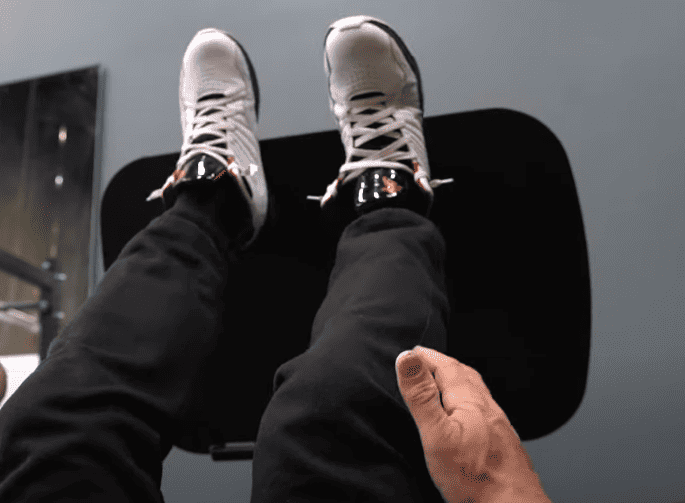
Placing your feet narrow and high on the footplate can help to target the hamstrings. Keep your feet close together, with your toes pointing upwards towards the platform’s top.
This foot placement emphasizes the hamstrings while also engaging the glutes. It’s a good option for individuals with longer legs.
2. Wide and low
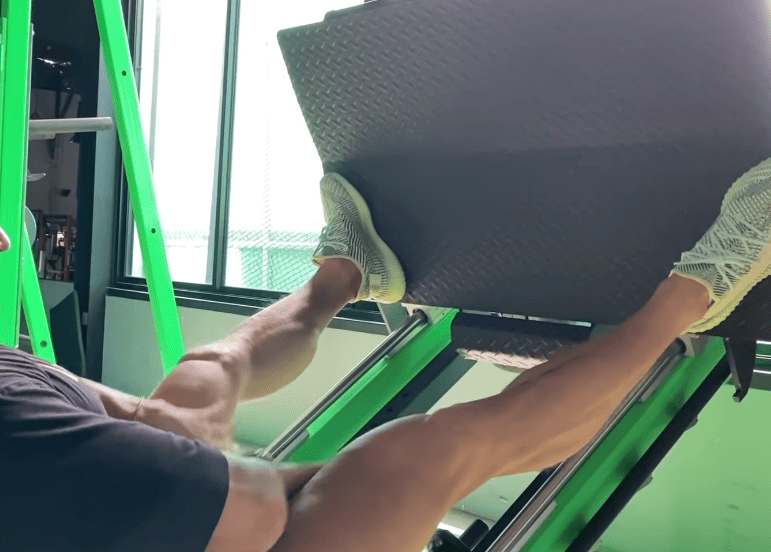
More comprehensive foot placement on the leg press with toes pointing outward targets the inner thighs, glutes, and hamstrings.
This foot placement is particularly effective for individuals with wider hips. Keep your feet wider than shoulder-width apart, and let your toes point outward.
3. Single leg
Single-leg leg press foot placement is an advanced exercise that targets each leg individually, engaging the hamstrings, glutes, and core. Place one foot on the footplate while lifting the other leg off the platform.
This placement can be difficult, making it ideal for advanced individuals looking to increase their hamstring strength and definition
Here’s a summary of hamstring leg press foot placement:
| Foot Placement | How to Do | Muscles Targeted |
|---|---|---|
| Feet high and wide |
1. Sit with your back against the pad and your feet on the footplate, wider than shoulder-width apart, and placed high on the plate. 2. Push the footplate away from your body by extending your knees and hips. 3. Pause at the top of the movement and then lower the weight back down. |
Hamstrings, glutes, calves |
| Feet low and close together |
1. Sit with your back against the pad and your feet on the footplate, closer than shoulder-width apart, and placed low on the plate. 2. Push the footplate away from your body by extending your knees and hips. 3. Pause at the top of the movement and then lower the weight back down. |
Hamstrings, inner thigh muscles, glutes |
Some of the vital benefits of leg press on the hamstrings include:
Improved hamstring strength
The leg press can efficaciously target the hamstrings, increasing overall strength in these muscles. This multiplied strength can translate to improved performance in different exercises and everyday activities that require lower body strength.
Decreased risk of injury
Strong hamstrings can help to reduce the threat of injury to the lower body, as they play a crucial function in stabilizing the knee joint and assisting the movement of the hips.
Also, read:
Best Leg Press Foot Placement For Glutes
You can improve your lower body strength, power, and overall fitness level by adequately performing the leg press and focusing on the glutes. Here are some of the best leg press foot placements for targeting the glutes:
1. Wide stance
Placing the feet wider than shoulder-width apart can help to activate the glutes more effectively during the leg press. This foot placement targets the outer portion of the glutes, which could help to enhance the general shape and size of those muscles.
2. High foot placement
Placing the feet higher on the footplate can also assist in targeting the glutes more efficiently. This foot placement targets the higher portion of the glutes, supporting a more rounded and lifted look.
3. Toe press
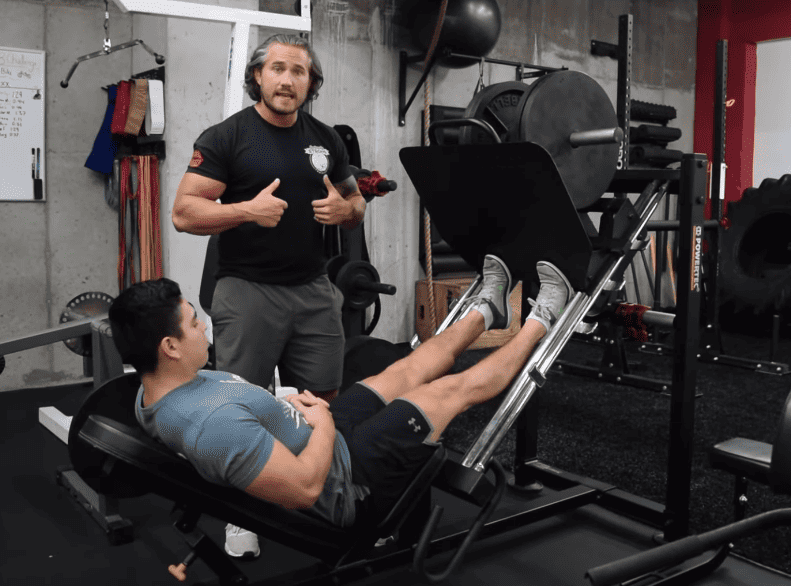
Pressing through the feet during the leg press can help to target the glutes more effectively. This foot placement emphasizes the glutes more than other muscle groups, helping maximize results.
4. Single leg press
Performing the leg press with one leg at a time can also efficiently target the glutes. This foot placement lets in for an extra remarkable range of movement and might assist in activating the glutes more completely.
Here’s a summary of how to do leg press on the glutes and the muscles targeted:
| Foot Placement | How to Perform | Muscles Targeted |
|---|---|---|
| Wide Stance | Place feet wider than shoulder-width apart on the footplate. | Gluteus Maximus, Adductors, Quadriceps |
| High Foot Placement | Place feet higher on the footplate. | Gluteus Maximus, Hamstrings, Quadriceps |
| Toe Press | Press through the toes during the leg press. | Gluteus Maximus, Hamstrings, Calves |
| Single Leg Press | Perform the leg press with one leg at a time. | Gluteus Maximus, Hamstrings, Quadriceps, Calves |
One of the primary benefits of leg press for the glutes is advanced strength and size
The glute muscles are some of the largest muscles inside the body, and by targeting them through leg press exercises, people can see improvements in their glute development and overall look.
Another benefit of leg press for the glutes is progressed muscle endurance
By performing leg press exercises with proper form and progressively increasing weight and repetitions; individuals can enhance the endurance of their glute muscle groups.
Best Leg Press Foot Placement For General Workout
The leg press is a popular workout machine targeting numerous muscle groups in the decreased body. Proper foot placement is critical to achieving maximum engagement and ensuring a safe and effective workout.
One of the most common foot placements for the leg press is a shoulder-width stance, with feet parallel to each other. This foot placement simultaneously goals the quads, hamstrings, and glutes, making it an excellent alternative for a general lower-body workout.
Individuals can adjust the foot placement slightly by setting the feet closer together or broader aside to target specific muscle groups.
Another popular foot placement for the leg press is the sumo stance, with feet wider than shoulder-width apart and toes pointed outward.
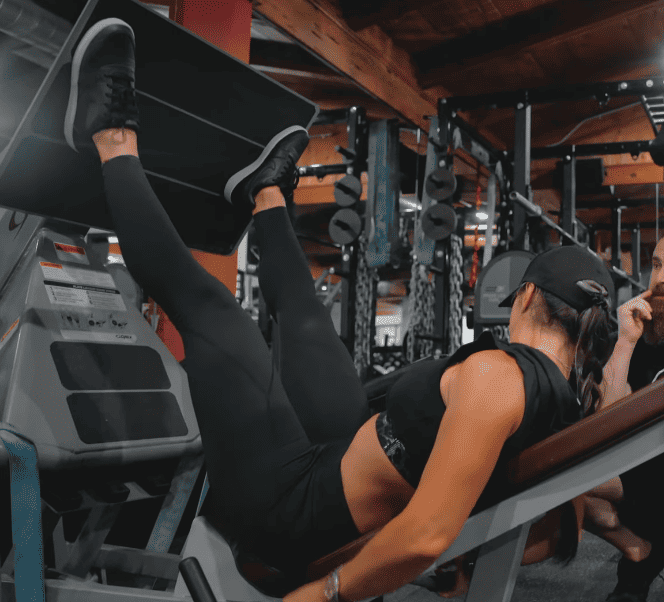
This foot placement can target the inner thigh muscles, adductors, quads, hamstrings, and glutes. It can additionally provide a more impressive range of motion and allow extra weight to be lifted, making it a challenging choice for advanced lifters.
For individuals explicitly targeting the glutes, a foot placement with the feet higher up on the platform and toes pointed outward can be effective. This foot placement can also target the hamstrings, but it’s avoiding placing too much strain on the lower back is essential.
Here’s a summary of leg press foot placement in general workouts:
| Foot Placement | Targeted Muscles | Benefits |
|---|---|---|
| Shoulder-width stance, feet parallel | Quads, hamstrings, glutes | Provides a balanced workout for lower body muscles. |
| Narrow stance, feet close together | Quads, with emphasis on outer quads | Targets the outer quads and improves definition in that area. |
| Wide stance, feet wider than shoulder-width, toes pointed outward | Quads, hamstrings, glutes, adductors | Targets a variety of lower body muscles and can improve overall leg strength. |
| High foot placement, toes pointed outward | Glutes, hamstrings | Targets the glutes and hamstrings, which can help with lifting and overall lower body strength. |
| Low foot placement, toes pointed forward | Quads, with emphasis on inner quads | Targets the inner quads, which can improve overall leg symmetry and balance. |
The leg press is a versatile and practical workout that can provide various advantages in general workouts. One significant advantage of the leg press is that it can target various lower body muscles, including the quads, hamstrings, glutes, and adductors.
By the use of different foot placements, people can adjust their workout to focus on particular muscles or attain a more balanced workout for general lower body strength.
Another benefit of the leg press is its low-effect exercise, making it an excellent option for individuals with joint pain or those recovering from injuries. It could also be an excellent opportunity for squats for individuals with difficulty correctly performing the movement.
Also, check out:
What are the Muscles used in Leg Press?
The leg press is a famous workout that targets various lower body muscles. The primary muscles within the leg press are the quadriceps, hamstrings, and glutes. The quadriceps are the muscles positioned on the front of the thigh, responsible for extending the knee joint.
The hamstrings on the lower back of the thigh are liable for flexing the knee joint and lengthening the hip joint. The glutes, or the buttocks muscles, extend the hip joint.
The leg press can help improve general leg strength, balance, and stability by engaging these lower body muscles. It can also improve overall performance in sports and daily activities requiring lower body strength, including going for walks, jumping, and lifting.
Conclusion
In conclusion, the Leg Press workout is an incredibly effective lower-body exercise that targets numerous major muscle groups: quadriceps, hamstrings, and glutes.
By adjusting the foot placement on the sled, you can shift the emphasis onto specific muscles, such as the calves or inner and outer thighs.
Understanding the best foot placement for different muscle groups can help you get the most out of your Leg Press workout and achieve your fitness goals more efficiently.
So, whether you’re looking to build muscle strength, tone and sculpt your lower body, or improve your overall fitness level, incorporating Leg Press with proper foot placement can be a valuable addition to your workout routine.
FAQs
Where should your feet be for leg press?
The placement of your feet during a leg press exercise can vary depending on the specific muscles you want to target. For the quads, placing your feet shoulder-width apart and higher on the footplate can be effective. A wider stance and lower foot placement can help strengthen the glutes and hamstrings.
Does foot placement matter on leg press?
Yes, how you position your feet on the leg press machine can affect which muscles are targeted and therefore make for a more or less effective workout.
Can you do a leg press wrong?
It’s possible, but only if you don’t use good form and get coaching from a fitness professional.
Do you push with heels or toes on leg press?
To target specific muscles, you can alter your foot position when doing a leg press. For example, pushing through the heels rather than the toes will engage more of the targeted muscles and take the strain off the knees.
